Christmas, noir and Christmas-noir from Indicator
I’ve been making an effort to put a little distance between myself and the trashy exploitation I’ve spent so much time watching recently. This has involved dipping into the past through Indicator and the BFI, as well as finally cracking open some of my untouched Eureka releases of Asian fantasy and martial arts. To start, though, a couple of Christmas movies…
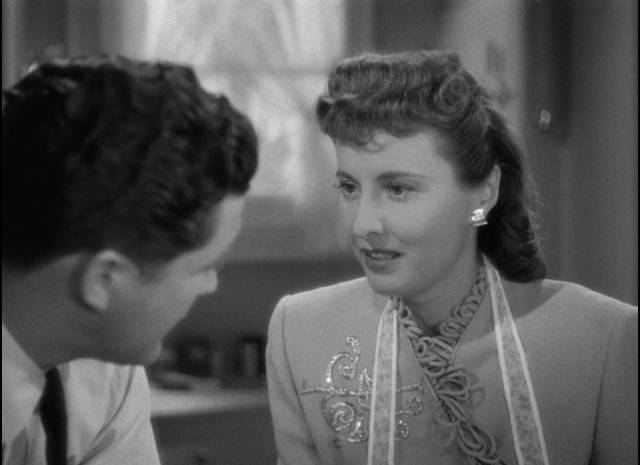
A Stanwyck Christmas
A few days before Christmas a couple of friends came over and we watched Peter Godfrey’s Christmas in Connecticut (1945), a classic screwball comedy starring Barbara Stanwyck, which concluded her brief reign as an icon of romantic comedy in the early ’40s. It’s a charming, and frantically paced, trifle which hits all the right notes, surrounding Stanwyck with a fine cast of character actors – Sydney Greenstreet, S.Z. Sakall, Una O’Connor – with Dennis Morgan as the straight guy romantic lead who anchors the swirling mayhem of confusion and deception.
Stanwyck is Elizabeth Lane, an enormously popular magazine writer whose persona as the perfect homemaker and cook is purely fictional. Her stuffy publisher (Greenstreet) has no idea she’s a fake and, as a publicity stunt, insists that she host a recuperating war hero (Morgan) at her Connecticut farm over Christmas. Unable to get out of the assignment, she talks architect John Sloan (Reginald Gardiner), who wants to marry her, into masquerading as her husband at his own place in the country. Although she has agreed to marry him, despite him being a pedantic bore, she naturally falls for her guest, who believes she’s a married woman and has to struggle with his own attraction as she comes on to him. With her boss also showing up, the misunderstandings accumulate rapidly before everything is finally resolved exactly as it should be. (From a four-disk Turner Classic Movies Holiday DVD set)
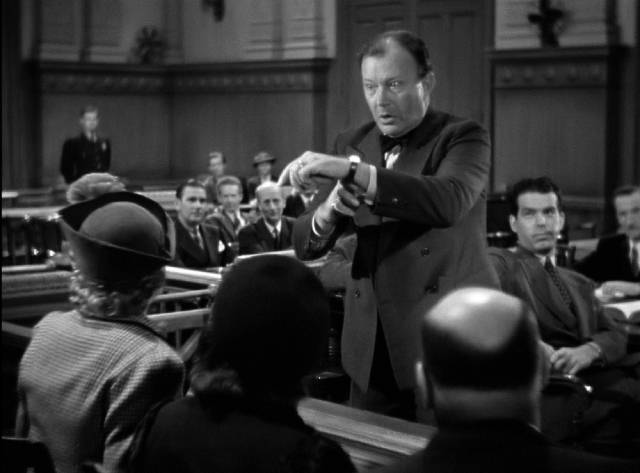
Remember the Night (Mitchell Leisen, 1940)
By coincidence, a few days after Christmas I received Indicator’s new limited edition of Remember the Night (1940), another Christmas comedy starring Stanwyck. This one I hadn’t seen before and it turned out to be something very different. Directed by Mitchell Leisen from a script by Preston Sturges (who wasn’t happy with the results and began his own directing career on the heels of this production), it doesn’t fall into a standard pattern despite the initial setup pointing towards a classic romantic comedy narrative. As the film progresses, it grows darker and more tonally complicated, edging from romantic comedy into romantic melodrama. In retrospect, there are hints of this darkness early on, while later the darkness is shot through with moments of humour, the whole held together and given seamless coherence by its attention to character.
Stanwyck is Lee Leander, whom we first meet (in the three opening shots) stealing a bracelet from a jeweller and being arrested. The DA assigns a reluctant John Sargent (Fred MacMurray) to the case because he has a knack for getting convictions of women and with Christmas a few days away, a jury will be predisposed to let Lee off. As Lee’s blowhard lawyer (Willard Robertson) wraps up the defence with a long, histrionic address to the jury in which he acts out Lee’s psychological state at the time of the crime, John sees an opening for postponing the proceedings until after Christmas, when it’ll be easier to get a conviction.
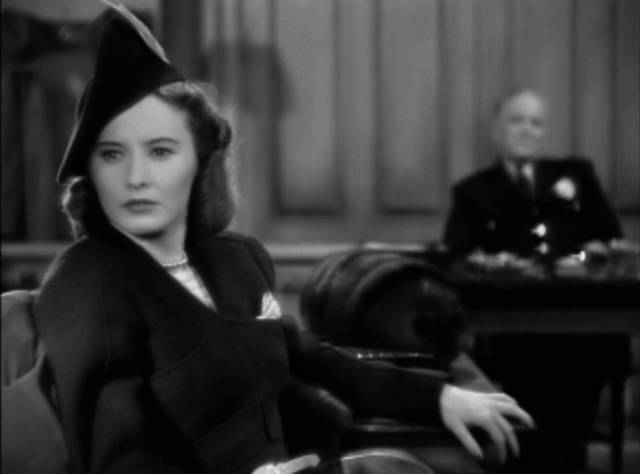
But as Lee is hauled off to jail for the holidays, John has a pang of conscience and arranges with bondsman Fat Mike (Tom Kennedy) to bail her out. As he prepares for his long drive back home to Indiana for a family Christmas, John is disconcerted when Mike dumps Lee on his doorstep. The bondsman, and Lee herself, have assumed that he arranged the bail as a way to extort sexual favours … with John naive and confused, it takes a bit of witty back and forth before Lee is convinced that the thought had never crossed his mind, at which point she relaxes and, with nowhere else to go, decides to settle in for the holidays.
Taking her to dinner at a nightclub, John finds her openness and paradoxical honesty about her criminality confusing – Stanwyck’s easy and knowing frankness is a sharp contrast with MacMurray’s confident yet unexamined propriety. But when they both realize that they grew up in the same part of the country, a mere thirty miles apart, something begins to change in the chemistry between them – something spotted by the trial judge, who happens to show up at the nightclub with his wife, shocked to find the prosecutor and the defendant enjoying an intimate evening together.
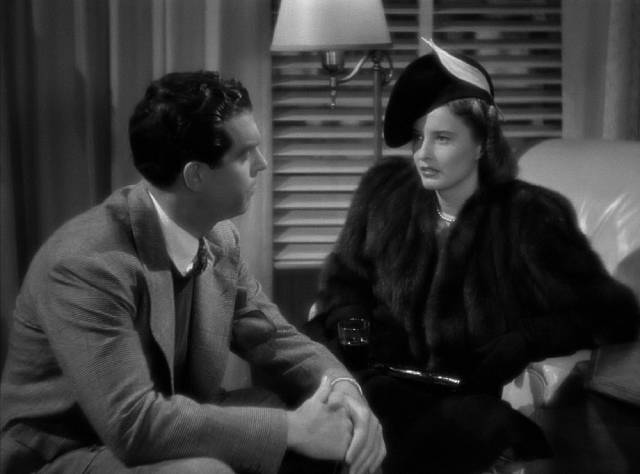
As John has to head out right away and as Lee has nowhere to stay, he offers to drive her home for the first visit to her mother since she left home. She has mixed feelings, but accepts … and suddenly we’re watching a road movie, with the pair gradually learning a bit more about each other as they encounter obstacles and incidents during the cross-country drive. Here again, there are familiar elements which take on less familiar shadings. With confusing detours, they get lost in the middle of the night and end up sleeping in the car in a field, waking in the morning surrounded by cows. As they struggle to obtain a little milk, a shotgun-toting farmer arrives and performs a citizen’s arrest for trespassing and theft … and for violation of the Mann Act[1] when it becomes apparent that the pair are not married. The impression outsiders get that there’s an illicit sexuality between Lee and John adds an edge to the slowly growing attraction between them.
Taken to a justice of the peace for their “crimes”, John and Lee fail to conceal an amused contempt for the hicks who, it quickly turns out, see right through them. Only Lee’s quick thinking gets them out of the jam as she drops a match into a wastepaper basket to create a distraction. As they cross the state line to safety, John is shocked to discover that she deliberately set the fire – “that’s arson!” – as she calmly points out that they barely escaped serious consequences for what were inadvertent errors they would gladly have paid for if the hostile farmer (who apparently made a habit of victimizing travellers who got lost due to the detours) hadn’t tried to involve the law. The idea of a personal accommodation to avoid those legal complications very much goes against John’s professional beliefs, but it gives him a glimpse of a different way of perceiving questions of right and wrong.
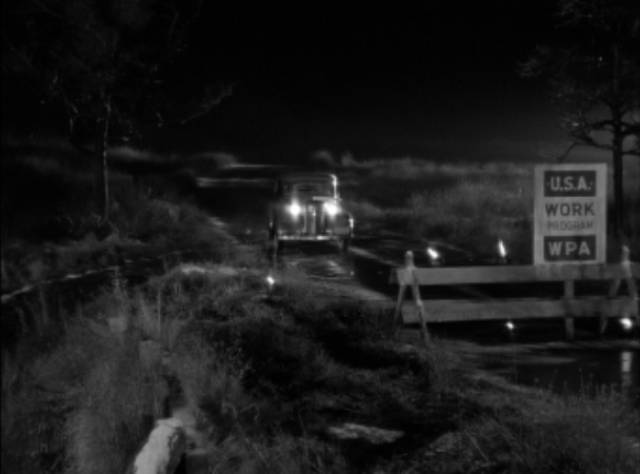
By this point it’s clear that the film’s central theme is the disconnect between who people are and the way other people perceive them – characters make assumptions about other characters and are all-too-ready to pass quick judgment. This seems to happen in all situations – we saw it in the courtroom when John made a cutting remark about Lee, which she overheard; it happened with Fat Mike, and again with the judge in the nightclub; it happened between the couple and the farmer and the justice of the peace. And now, with the film’s darkest tonal shift, we see just how damaging this tendency is when they finally arrive at Lee’s childhood home.
It’s night and the old house looks like something from a rural Gothic nightmare, its windows dark, the yard barren, dominated by a leafless skeletal tree, which Lee says she fell out of as a child. Becoming increasingly fearful, she finally knocks at the door and a scowling man appears out of the gloom. This turns out to be her mother’s second husband. And then her mother (Georgia Caine) appears, a grim, unforgiving figure. In a brief scene, John learns all he needs to know about how Lee has become who she is. As a girl, she took money from her mother, intending to pay it back, but her mother exposed her as a thief in front of the town, making it impossible for her to remain in the community. And all these years later, she’s just as unforgiving, dismissing as worthless the daughter who became what she was accused of being.
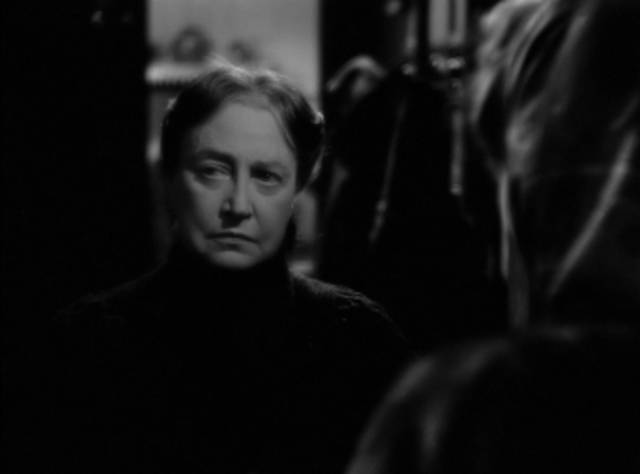
It’s obviously impossible for Lee to stay here and John says they have to be on their way, trying to save face without actually coming out and saying what he thinks of the cruel woman. At her lowest ebb, Lee barely registers that he has invited her to come home with him. And now there’s another radical shift in tone as we find ourselves at the Sargent farm where John’s mother (Beulah Bondi), Aunt Emma (Elizabeth Patterson) and cousin Willie (Sterling Holloway) are rushing to get everything ready for John’s arrival. Sitting in the car, Lee watches the warmth and excitement of a family reunion rooted in affection rather than judgment and is uncertain when that warmth is turned on her and these strangers take her in without a moment’s hesitation. The contrast could so easily have been crude and cloying, but Leisen and the cast infuse the moment with an easy naturalism which leaves it up to the audience to draw the necessary conclusions. Of all the contrasts in Sturges’ script, this is the riskiest, with the potential for a cartoonish didacticism, but Leisen handles it with an easy, unforced charm, moving the scene along without any attempt to underline the point.
There’s nuance to this family, which keeps things from falling into a simple black-and-white contrast. Lee takes a while to settle in and accept their acceptance, gradually letting down her guard and joining in the little rituals of the season. But she doesn’t know that John has already told his mother the truth – that he and Lee are not a couple, that after the holiday he’ll do his best to convict her and send her to jail. Here we learn that as a boy he himself had done what Lee did, taking money from his mother – but rather than condemning him, she took it as an opportunity to teach him a valuable lesson about right and wrong, enabling him to go on and make something of himself.
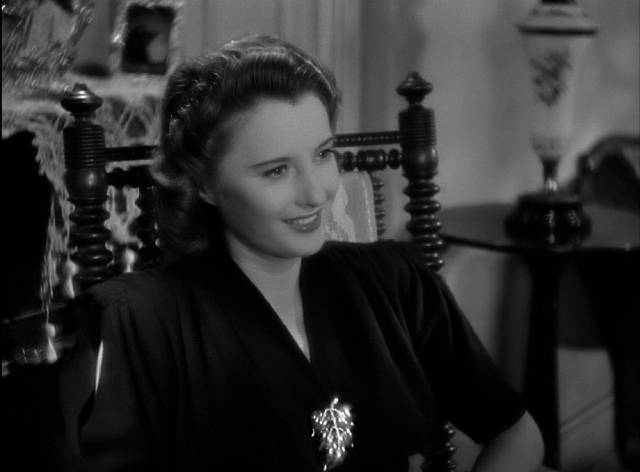
This reminder, and what he’s just seen of Lee’s background, complicates things for him. The person he’s become as a prosecutor is predicated on a relatively simple view of morality – transgressors need to be punished – but the emotional connection which has been growing between him and Lee has awoken him to mitigating factors which make law and justice seem less firmly aligned. His mother is more aware of this than he is and, although sympathetic to Lee, she sees John’s feelings as a risk to the life he’s made for himself. She wants to think that he’s sensible enough to avoid such pitfalls, but seeing the pair together at the town’s New Year’s dance makes it obvious that love is winning.
Back home, as everyone says goodnight, John invites Lee to join him in his room “for a smoke” – the sexual subtext here is so obvious that it’s surprising it made it past the censors – but the potential consummation of their romance is headed off at the pass by John’s mother, who goes to Lee’s room for a serious chat. In what may be the movie’s finest scene, she shows empathy even as she fights to “save” her son from his own feelings by showing Lee just how dangerous a relationship with her would be for him. The understanding between the two women effectively removes John’s own agency from the situation – they both feel real pain, but recognize that as women they must sacrifice something of themselves for the good of the man.
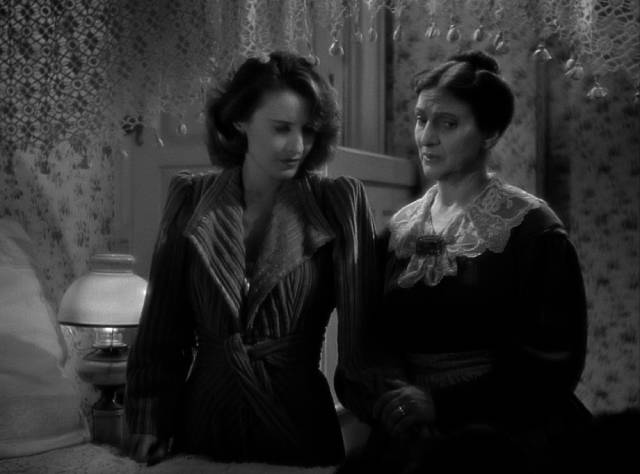
Yes, this is a problematic attitude rooted in a more rigidly patriarchal time, but thanks to the performances it’s not as simplistic as it might be. In fact, it lays the foundation for Lee’s final transformation, regaining for herself a sense of agency which had long ago been stripped away by her mother’s cruelty. (This reflects back to her lawyer’s monologue in the early courtroom scene in which his entire argument was that Lee had no agency when she took the bracelet, but was effectively in a trance brought on by the hypnotic power of the jewellery and the salesman’s persuasive pitch.)
Back in New York for the resumption of the trial, with the judge and the DA suspicious about the apparent relationship between John and Lee, John does his best to throw the case by being so hard on Lee as she testifies that the jury will take pity on her … but Lee will have none of it, not simply to protect him from a career-ruining mistake, but to fix her own life and possibly pave the way for their relationship in the future. Resisting John’s efforts as well as her own lawyer’s advice, she pleads guilty and in a strikingly open-ended conclusion the film defies convention by depriving us of a tidy resolution, their romantic feelings caught up with issues of conscience and the implacable machinery of the law. There’s hope mingled with despair and for once Hollywood’s imperative to give a romantic couple exactly what they (and we) want is stymied. What began as a romantic comedy has ended as a melodrama which almost slips into tragedy.
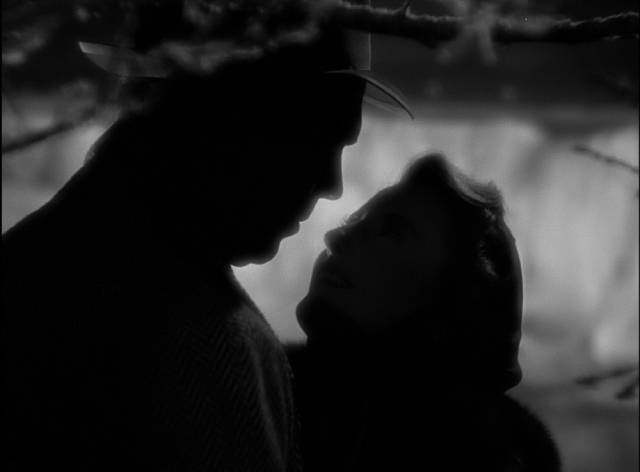
Leisen’s handling of all the tonal shifts seems effortless and every sequence serves to support the emotional evolution of the two characters. Stanwyck was never better than here – the subtlety of her acting conveys so much without the need for dialogue that Leisen can hold on her face for long stretches, revealing thoughts and feelings as they take shape and evolve. It’s very much her movie; MacMurray’s John is naive at times to the point of being oblivious – it seems that his loving and supportive family have sheltered him from much of the world’s hardness, which makes him decent and likeable but less mature than Lee, who has had to struggle and has little respect for rules and propriety.
Apparently Leisen cut as much as a half-hour from Sturges’ script, yet the movie feels complete and well-structured. Sturges has filled it with scenes which double one another and Leisen’s staging and camerawork reinforce the sense of duality which is embodied by the two characters, the struggle to find a middle ground where their relationship can flourish. But in a complicated world, this is not so easy. Sturges himself said that Remember the Night is the story of a woman redeemed by love and a man undone by love and the fact that Lee and John pass each other on their way to new transformative insights – he comes to understand the limitations of laws applied to messy human motivations, she comes to take personal responsibility for her own actions and their social consequences – gives the movie depth and maturity.
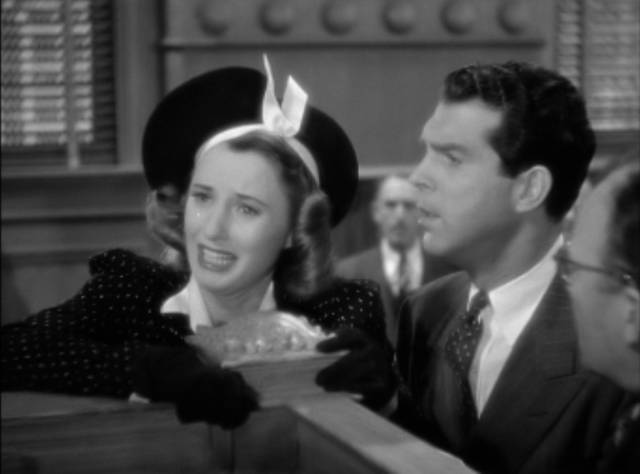
Leisen’s handling of the script’s doubling is at times subtle and dramatically powerful, particularly in the two key moments involving Lee and the mirrored mothers. On the front step of the family home, in despair, Lee declares that she wished she’d died when she fell out of the tree and in the background we glimpse her mother looking out of a window and simply turning away, devoid of feeling. Later, in her room at the Sargent home, after her conversation with John’s mother, we see the older woman reflected in the mirror as she goes to the door, pausing to look back and say “you do love him” … and Lee replies “yes”, knowing that it’s hopeless, though ironically John’s mother fully understands her and is even sympathetic, unlike her own mother. But in a way, that understanding gives this moment greater emotional cruelty than her own mother’s rejection.
The film looks excellent on Indicator’s disk, with Ted Tetzlaff’s cinematography deftly handling the constantly shifting moods from big city romantic comedy to rural family coziness to intimations of film noir and touches of the outright Gothic. The extras aim to redeem Leisen’s reputation from the accepted wisdom that he couldn’t direct actors or understand story – an impression grounded in the narrative that it was his mishandling of scripts by Sturges and Billy Wilder which compelled those two successful writers to become directors themselves. Adrian Martin’s commentary, an interview with Geoff Andrew and a lengthy 1994 article by Dennis Drabelle from Film Comment reprinted in the booklet go a long way towards correcting this impression … and make me want to seek out more of Leisen’s work.
There are also two radio adaptations and a 1945 short promoting government bonds which features numerous Hollywood stars, including Stanwyck.
Finally, Pamela Hutchinson provides an account of Stanwyck’s career which runs almost half-an-hour … which in a way I’m sorry I watched as it told me more about one of my favourite actresses than I wanted to know, particularly that she was a lifelong right winger and a supporter of the post-war blacklist which wrecked the careers of so many people in Hollywood because of their left-leaning beliefs.
*
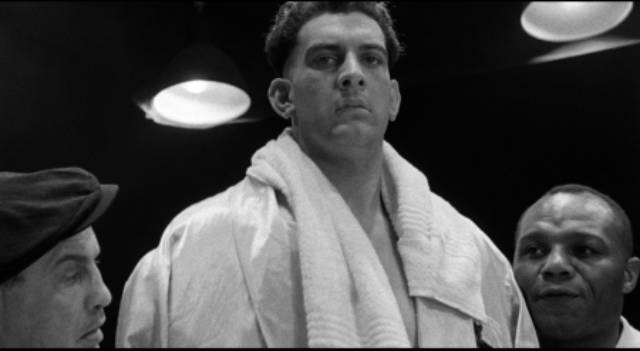
Columbia Noir #5: Humphrey Bogart
After recently watching Indicator’s first volume of Universal films noirs, I finally got around to watching the fifth Columbia Noir set which had been sitting on the shelf for months. The delay was due to the fact that, unlike the previous sets in the series, this one focused on a major star which paradoxically made it less interesting to me – the earlier sets had a sense of discovery, while this one covered more familiar ground, an impression borne out when I finally did watch all six movies. Which is not to say that I didn’t enjoy them…
While the first four Columbia sets (and the recent Universal box) focus on noir as a genre, this one centres on the star persona of Humphrey Bogart. As a Bogart fan, that in itself isn’t a problem for me, but several of the movies included do simply coast on his image, recycling familiar elements without a lot of imagination or originality. Two, in fact, are almost projections of what might have happened when Rick returned from the war and tried to resume life at the Cafe Americain. At least two more don’t really count as noir, and one of them doesn’t even have Bogart in the cast – it was merely produced by his company.
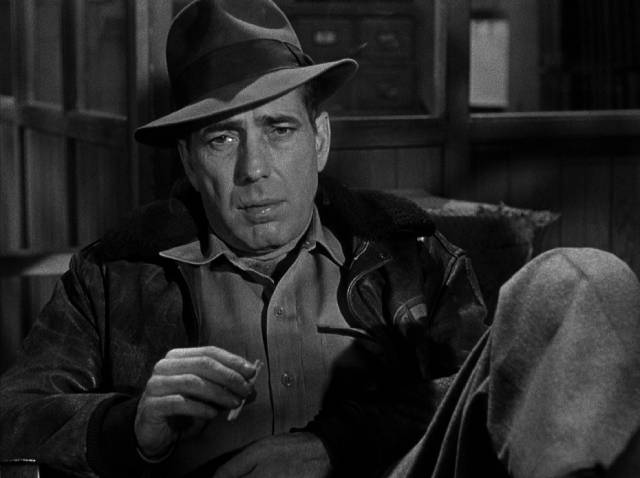
Tokyo Joe (Stuart Heisler, 1949)
Both Stuart Heisler’s Tokyo Joe (1949) and Curtis Bernhardt’s Sirocco (1951) lean very hard on memories of Casablanca (1942) but fail to catch the spark which has kept Michael Curtiz’ classic alive for eighty years. In both, Bogart plays a jaded man who tries to rebuild a former life while remaining detached from the political and social complications arising from war. In Tokyo Joe, he’s the former owner of a Ginza bar and gambling joint who shows up in occupied Tokyo and gets caught up in American red tape and the nefarious plans of a secret organization of former Japanese military officers planning to overthrow the government imposed on Japan at the end of the war. To complicate things, he tries to reclaim the woman he left behind years ago, who’s now married to another man, not realizing at first that their young daughter is actually his child. Unfortunately, there’s absolutely no chemistry between Bogart and Florence Marly and he’s rather awkward interacting with little Lora Lee Michel who plays the cloying daughter. He fares better with the action elements which include several sequences involving arms smuggling and transporting wanted war criminals, climaxing in an act of self-sacrifice when the bad guys kidnap the little girl to apply pressure on him to carry out their plans. The most notable aspect of the movie is some actual location shooting in occupied Japan, the first done by an American production since the end of the war – though it was all just second unit work using a double for Bogart. (It would be another six years before Sam Fuller would shoot an entire feature in Japan, the much better House of Bamboo [1955].)
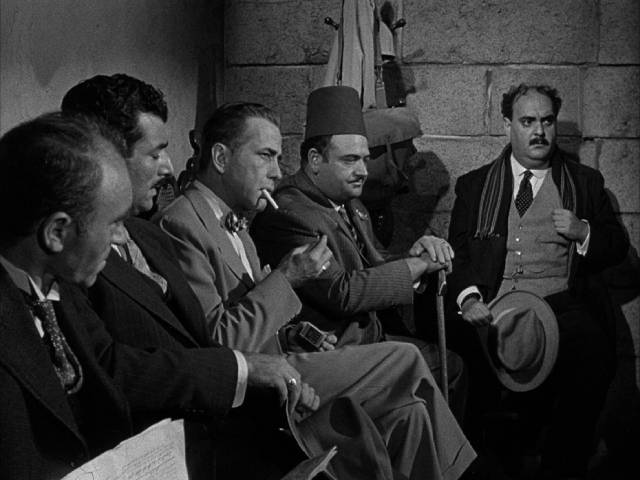
Sirocco (Curtis Bernhardt, 1951)
In Sirocco, Bogart is a former saloon owner turned gun-runner in 1925 Syria, making money by supplying weapons to a faction trying to overthrow French colonial rule. While trying to remain morally disengaged, he naturally gets drawn into the politics when he’s targeted by French intelligence in the form of Colonel Faroud (Lee J. Cobb), with whose mistress Bogart becomes involved. The most interesting thing about the movie is how it becomes twisted in knots around the issue of colonialism and resistance. The French are initially presented quite critically – Faroud’s superior wants to arrest and summarily execute random Syrians to assert French authority, though Faroud manages to talk him out of it because any such action would guarantee an increase in resistance. But Faroud is also a bit of a bastard, particularly when it comes to his mistress and her obvious loss of feelings for him. And yet, despite having set up sympathy for the independence movement, the movie gradually comes down on the side of the French and their “civilizing” mission, the Syrians eventually being dismissed as “fanatics”.
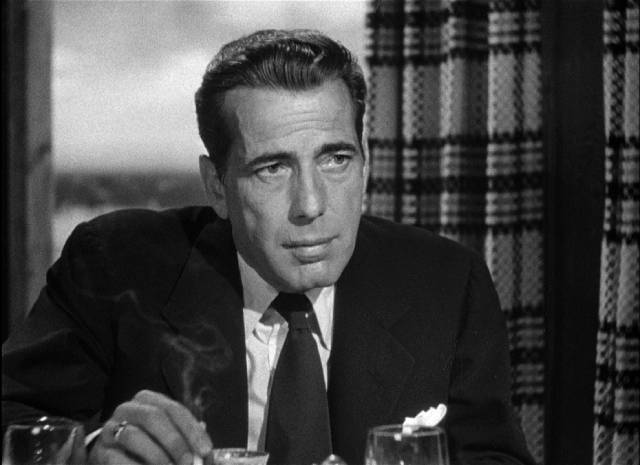
Dead Reckoning (John Cromwell, 1947)
Less problematic is the more noirish Dead Reckoning (1947), efficiently directed by John Cromwell. Bogart plays Captain “Rip” Murdoch who’s on his way to receive a medal with one of his men. But something’s wrong, and his buddy runs away rather than attend the public ceremony. Rip gets permission to investigate and discovers something troubling in the man’s past – a murder for which he had joined up to avoid being arrested. When his buddy turns up dead, Rip digs deeper and gets himself tangled with criminals and a femme fatale (Lizabeth Scott, no stranger to such roles). The movie is solid if not particularly original or inspired and Bogart is a no-nonsense hero who inevitably sorts out the bad guys by the end.
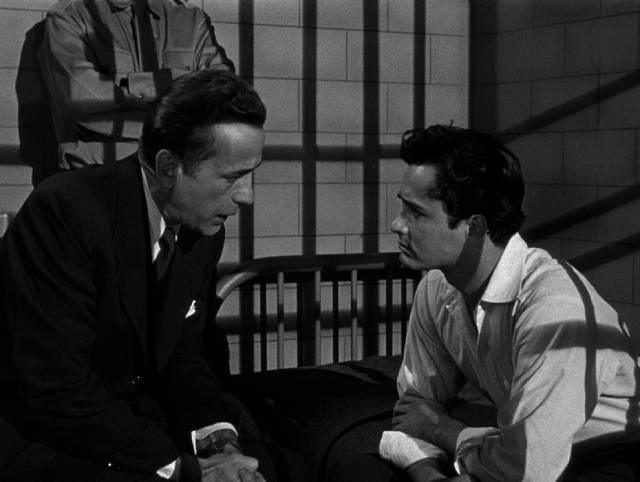
Knock On Any Door (Nicholas Ray, 1949)
He’s perhaps a little less at home in Knock On Any Door (1949), the third feature directed by Nicholas Ray. More a social issues drama than noir, it never quite finds the balance between well-meaning speechifying and old-fashioned crime story. Bogart is a big-shot attorney who finds his life entangled with that of a kid from the slums who’s been arrested for killing a cop. Between the trial and a long string of flashbacks, we learn about how the kid (the first major role for John Derek, better known eventually for marrying Bo Derek and directing her in a couple of soft core features) never had a chance because of the crime-ridden neighbourhood he was born into. Tugging at the attorney’s conscience is the fact that he had encountered the kid back when he first got in trouble but hadn’t done enough to help him get out of a gang involved in petty crime. Bogart can’t save the kid (who really did kill the cop), but he makes a passionate speech in court about society being to blame. (I couldn’t help recalling the words of Duke as he dies in Repo Man: “I know a life of crime has led me to this sorry fate, and yet I blame society. Society made me what I am.”)
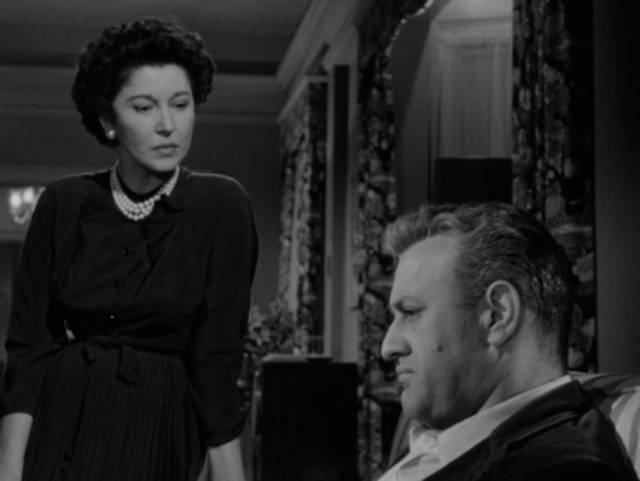
The Family Secret (Henry Levin, 1951)
The odd film out in the set is Henry Levin’s The Family Secret (1951), on which Bogart was the uncredited executive producer. In a kind of mirror image of Knock On Any Door, John Derek is once again a killer, though here he’s the spoilt son of a middle class family who accidentally kills his best friend during an argument outside a bar. His big-shot lawyer father (Lee J. Cobb) and mother (Erin O’Brien-Moore) both fairly quickly realize he’s guilty, but since he refuses to accept responsibility and Mom insists there’s no point in ruining his career prospects and the family reputation over a little matter of manslaughter, Dad keeps quiet, though when a minor bookie (Whit Bissell) is charged with the crime, he decides to defend the man. Meanwhile, the boy spends his time hitting on Dad’s secretary and not seeming to care much about what he’s done. After the bookie dies of a heart attack on the stand, it seems that the case is closed and he can just get on with his life. There’s no room here for the kind of audience sympathy the kid earns in Ray’s movie; he’s a rich brat who thinks he doesn’t owe anyone anything. He remains untouched by the death of his best friend and his Mom is fine with that. Only Dad displays any conscience, but even he won’t act even though his son and wife now disgust him. It’s an odd movie which plays with audience identification in unexpected ways, but even though it finally reaches a resolution it comes too late for us to care about the characters.
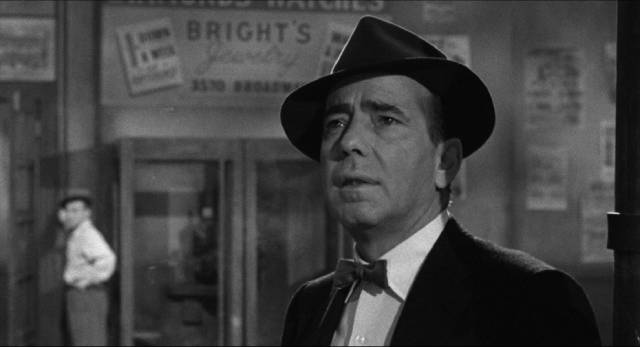
The Harder They Fall (Mark Robson, 1956)
As uneven as these movies are, the set ends with one of Bogart’s finest films – also, in fact, his final film, made while he was dealing with the cancer which would kill him soon after the movie was completed. Mark Robson’s The Harder They Fall (1956) is one of a number of Hollywood movies which focused on the seamier side of boxing, a world in which criminals and managers exploited fighters whose bodies were the raw material for the production of profits. Bogart is Eddie Willis, a washed-up sports reporter who reluctantly takes a gig as press agent for shady promoter Nick Benko (Rod Steiger), who has imported a giant named Toro Moreno (Mike Lane) from Argentina, a physically impressive figure who can’t fight to save his life. Needing money, Eddie starts building a phony reputation for Toro while Benko pays off a series of fighters to take a fall, creating the impression that Toro is an unstoppable force heading for the heavyweight championship.
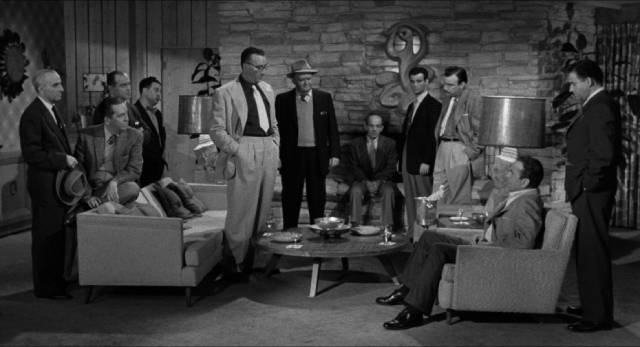
As the plan begins to take its toll – on Toro’s body and Eddie’s conscience, which is increasingly prodded by his wife Beth (Jan Sterling) who can see just how corrupt the situation is – Eddie gradually turns against Benko and eventually helps Toro to escape back to Argentina. Faced with the mobster’s threats, Eddie finally rediscovers a sense of honesty and the movie ends with him setting out to expose corruption in the fight racket. Robson, whose first feature after serving his apprenticeship under Val Lewton at RKO was another boxing classic, Champion (1949) starring Kirk Douglas, obviously had an affinity for the violent sport, while also recognizing its depressingly dark underside. The Harder They Fall is a taut, viscerally violent drama made without a single wasted moment and Bogart seizes the opportunity to display his signature battered nobility one last time, his early cynicism progressing towards redemption through stages defined by each new revelation of Benko’s corruption.
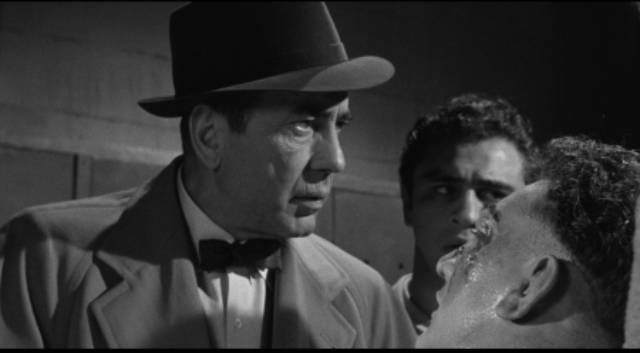
Apparently Bogart had little patience for Steiger’s Method affectations, but the clash between their acting styles adds dramatic tension to the film, their scenes together full of sparks. The rest of the cast are also excellent, from Mike Lane’s naive Toro to Harold J. Stone’s honest sports reporter, Edward Andrews’ sleazy manager, even former heavyweight champions Max Baer and Jersey Joe Walcott playing versions themselves. Jan Sterling manages to make an impression in what could have been a thankless role as Eddie’s wife, who can see what his agreement with Benko is doing to him long before he wises up himself.
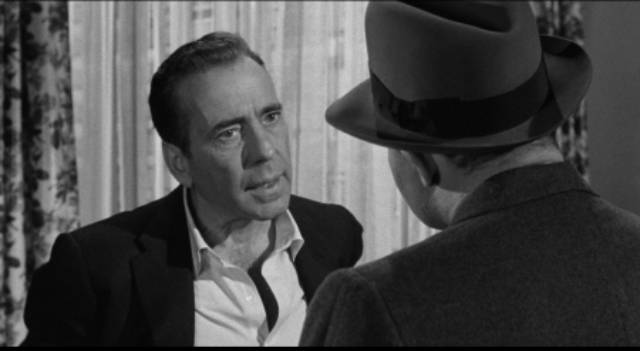
Although I have no interest in boxing per se, in movies like this it serves very well as a metaphor for Capitalism and the way owners use and abuse labour in their insatiable pursuit of profit. Robson was an uneven director, but he never made a better film than The Harder They Fall.
As always, Indicator offer excellent transfers of all six features and pack the disks with extras, including commentaries, interviews, video essays and appreciations by critics, historians and filmmakers. There are no Three Stooges shorts this time, but each disk contains contemporary documentary shorts, including a couple aimed at recruiting African Americans into the army and navy, one about the formation of the United Nations, another about the 1944 presidential election, and a fundraiser for the United Jewish Appeal featuring John Derek, plus a couple of archival super-8 films of Max Baer fights.
___________________________________________________________
(1.) From Wikipedia: “In its original form the act made it a felony to engage in interstate or foreign commerce transport of ‘any woman or girl for the purpose of prostitution or debauchery, or for any other immoral purpose’. Its primary stated intent was to address prostitution, immorality, and human trafficking, particularly where trafficking was for the purposes of prostitution. It was one of several acts of protective legislation aimed at moral reform during the Progressive Era. In practice, its ambiguous language about ‘immorality’ resulted in it being used to criminalize even consensual sexual behavior between adults.” (return)
Comments
“Thank you for yet another thought-provoking and engaging article! I have always found the intersection of Christmas and noir to be fascinating, and your analysis of the films from Indicator is truly insightful. It’s refreshing to explore the darker, grittier side of the holiday season through these cinematic gems. Your website never fails to deliver exceptional content, and I look forward to reading more. Keep up the excellent work! Best regards, Gary Ford”